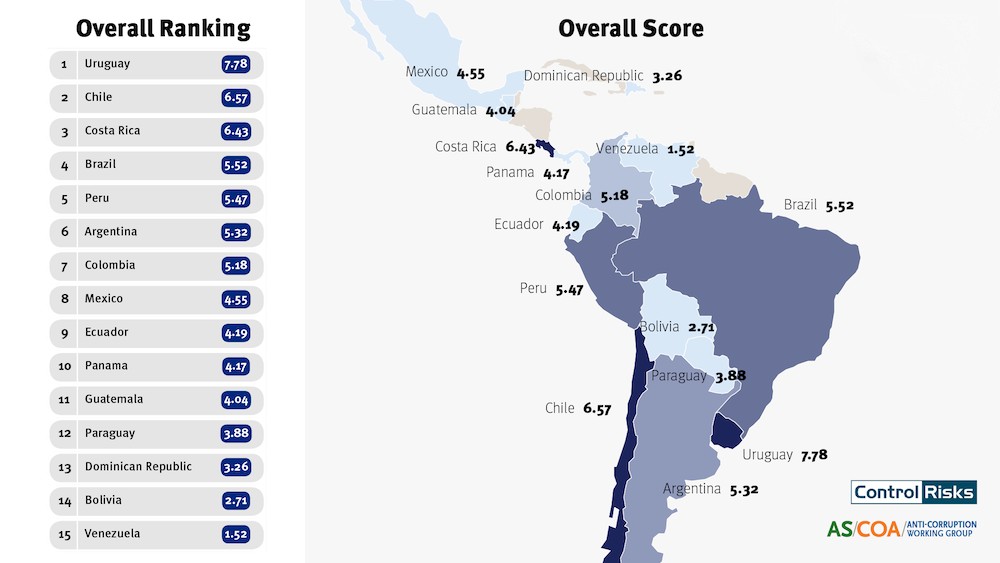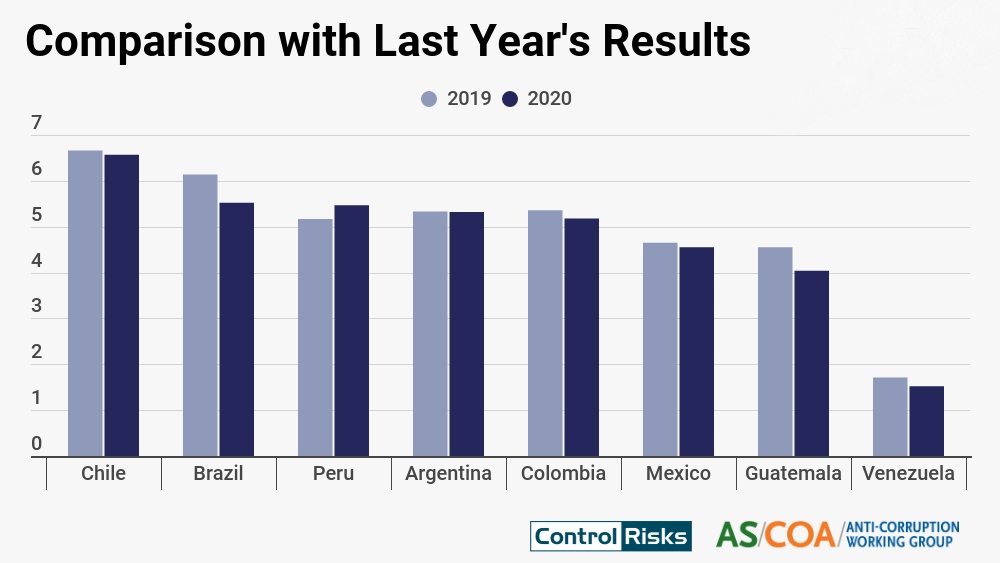In today’s environment of emergency government spending and programs, flexibilization of procurement processes and controls, and the sudden and unrehearsed shift to mass remote working in response to the COVID-19 pandemic, the risk of fraud and corruption has increased substantially across Latin America.
Unfortunately, this situation coincides with troubling anti-corruption enforcement trends in the region. The 2020 Capacity to Combat Corruption (CCC) Index, published by Control Risks and AS/COA, reveals that the anti-corruption wave in Latin America, which gained steam in 2014 is now stagnating across the region and even waning in some countries.
The second edition of the CCC Index covers 15 Latin American countries comprising 95% of the region’s GDP. Rather than measuring perceptions of corruption or resulting economic damage, the CCC Index evaluates countries based on how effectively they tackle the problem. Countries with a higher score are deemed more likely to prosecute and punish corrupt actors.

Uruguay ranks highest on the index with a score of 7.78 out of 10, meaning it has been deemed the most likely to uncover, punish and deter corruption. The overall score is composed of three categories: Legal Capacity; Democracy and Political Institutions; and Civil Society, Media and the Private Sector.
A worrisome picture for Latin America

When comparing results for the eight countries featured in last year’s index, Chile, Argentina, Colombia and Mexico have stagnated while Brazil, Guatemala and Venezuela saw decreases in their overall scores. Peru was the standout exception, showing an improvement over the previous year’s assessment. Only one country in each category improved its score from last year: Peru in Legal Capacity; Argentina in Democracy and Political Institutions; and Colombia in Civil Society, Media and the Private Sector.
The reasons for stagnation or regression vary. In a number of countries, the entrenched political class fought back against anti-corruption efforts. In others, anti-corruption efforts were used to target political foes. After several years of major anti-corruption operations, many Latin American countries are now experiencing enforcement fatigue. Attention has shifted to economic issues and human rights, which were at the forefront of massive protests in several countries in late 2019.
In some of the larger economies, we see a mixed picture. Although Brazil ranks fourth overall in this year’s index, it presents one of the most concerning trajectories in the region with a 10% decline in its overall score, mainly due to a fall in its Legal Capacity score, which dropped 14% over last year. Some of the decline’s leading causes are contentious judicial decisions that negatively impacted the capacity to investigate and punish corruption. Moreover, the president broke with tradition by appointing a chief prosecutor from outside the federal prosecutors’ shortlist. The president opted for an appointee he described as being more “aligned” with him, casting doubts on the position’s independence. Despite recent concerning developments, Brazil continues to demonstrate a relatively robust capacity to combat corruption.
Mexico, which ranked eighth, is another noteworthy case. Despite President Andrés Manuel Lopez Obrador’s campaign promise to end corruption, little has changed, as reflected in Mexico’s relatively low score, essentially unchanged from last year. This can be attributed to a lack of progress in long-term institutional reforms, relatively little importance given to the National Anti-Corruption System (SNA) and an increasing reliance on discretionary spending in public contracts. Mexico also saw the momentum behind its civil society anti-corruption campaign weaken, possibly due to AMLO’s success in appropriating the anti-corruption cause and his rhetorical attacks against NGOs and other independent groups.
Peru stands out for having improved its score in six of the Legal Capacity category’s seven variables. Of note are gains in the judicial system’s efficacy and independence—most notably through the contributions of the newly created National Justice Board (JNJ)—and more effective law enforcement. The improvements were underpinned by the priority President Martín Vizcarra placed on the anti-corruption agenda. These advances, combined with adverse outcomes in other countries, put Peru in fifth place, nearly on par with Brazil and ahead of Argentina and Colombia. Peru ranked behind all three countries in 2019.
Implications for businesses and their compliance programs
The index’s findings have significant implications for companies doing business in Latin America. They reveal an uneven and rapidly changing enforcement landscape complicated by the COVID-19 pandemic. This underscores the need for companies to update their risk assessments and adapt their compliance programs to manage corruption risks.
This means reinforcing a commitment to ethics and compliance through clear and consistent messaging from the board and leadership teams, ensuring the compliance department has sufficient independence and resources to implement and maintain an effective compliance program in the face of the challenging financial reality many companies face.
Third-party programs need to be reassessed and, in some cases, redesigned to enable compliance teams to onboard third parties in a quick and responsible manner. This is critical as companies explore opportunities and seek new partners to manage the significant supply chain disruption caused by the pandemic. Given how volatile the business environment is, third-party programs should enable the compliance department to monitor third parties once onboarded. This is one of the Department of Justice’s key recommendations in its recently updated guidance on the evaluation of corporate compliance programs. Compliance teams will need to deploy technology to aggregate and analyze third-party data and automate workflow.
Finally, given the heightened political instability across the region and the politicization of enforcement in a number of countries, monitoring political and regulatory risks is now an essential activity, not only for those at the business’ front lines but those responsible for programs to ensure business is conducted in an ethical and compliant manner.
